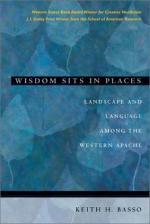
|
| Name: _________________________ | Period: ___________________ |
This test consists of 5 multiple choice questions, 5 short answer questions, and 10 short essay questions.
Multiple Choice Questions
1. What does Basso say the Western Apache discourse is a product of?
(a) Interlocking utterances and actions.
(b) Utterance and inaction.
(c) Inative syllables.
(d) Stories.
2. What does Basso say to pay attention to, in "Chapter 2, Stalking with Stories"?
(a) The lesson the story is teaching.
(b) Claims people make about themselves.
(c) History.
(d) Who told the story.
3. Whose brother does Basso overhear became ill while visiting Lola?
(a) Sophie's.
(b) Louise's.
(c) Lola's.
(d) Martha's.
4. At what elevation can the Cibecue settlement be found?
(a) 5,900 feet.
(b) 4,900 feet.
(c) 3,900 feet.
(d) 1,900 feet.
5. What does Basso say the story might have been?
(a) A lie.
(b) Misinterpreted.
(c) An elaborate insurance scam.
(d) The truth.
Short Answer Questions
1. What did Basso use to explain the effect of symbolism on individuals?
2. Why can't the Apache be too specific when telling a story, according to Basso?
3. Who did Nick Thompson claim needed printed maps?
4. Where did the story told by Emily happen?
5. How long does Basso say he had known Nick Thompson?
Short Essay Questions
1. Why has Basso used Apache conceptions of land?
2. What does the land make people do, according to the Western Apache?
3. How do local peoples relate to their geography?
4. What do younger Apache feel about village life, according to Basso?
5. Why does Basso think the Western Apache emphasize the importance of the land?
6. What does Basso advise people to pay attention to, in "Chapter 2, Stalking with Stories?"
7. What does "speaking with names" illustrate?
8. What looks after the Western Apache, according to Basso?
9. What can't materialist models not give an explanation of?
10. What must ethnographers be cautious of, in "Chapter 3, Speaking With Names?"
|
This section contains 555 words (approx. 2 pages at 300 words per page) |

|




